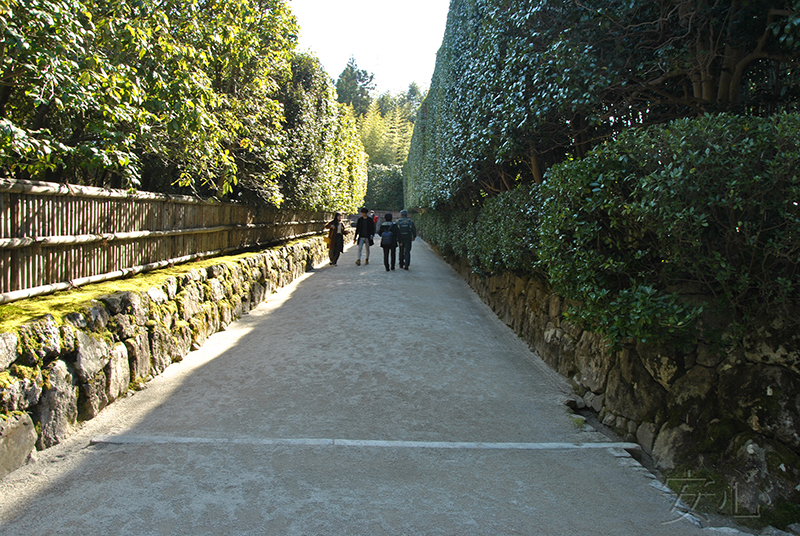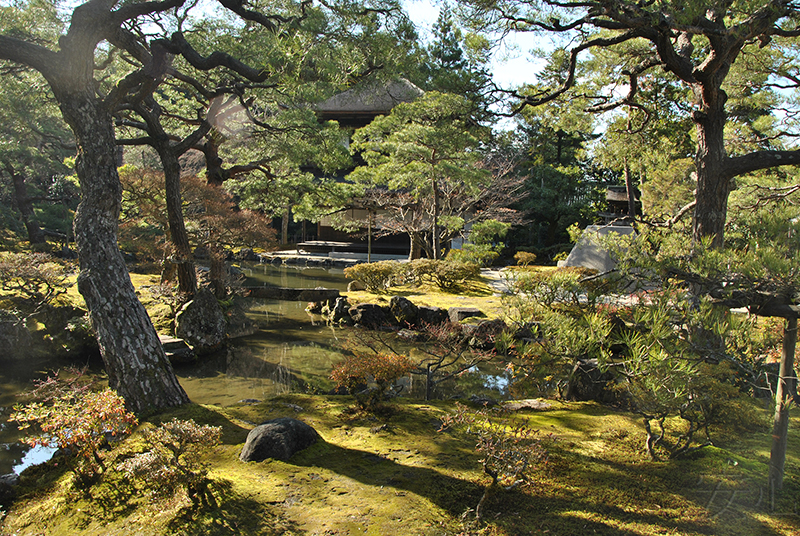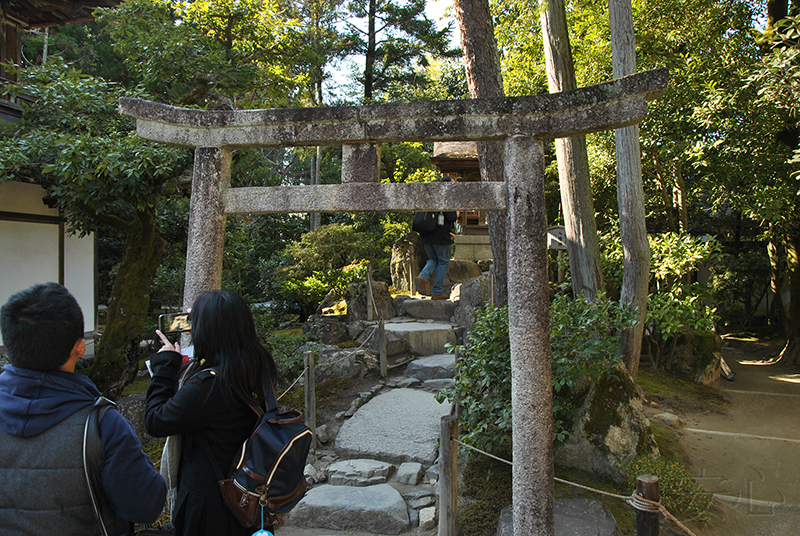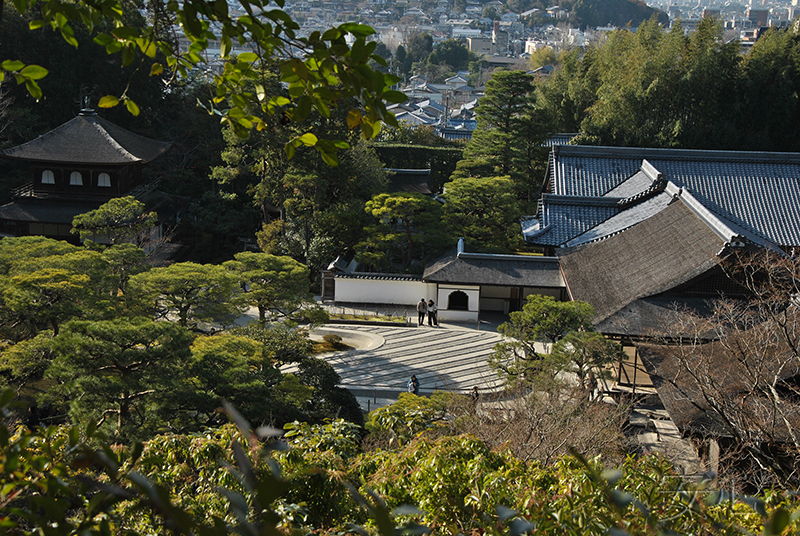
Ginkaku-ji Temple Garden, Kyoto
At first I hesitated whether I should go to this garden. It seemed to me that in highly promoted places it is not so interesting, there is no that atmosphere that is present in small and not so famous gardens. However, Ginkaku-ji is located near Shisen-do, so I decided to visit it. And I didn't regret!
Ginkaku-ji Temple (officially name is Higashiyama Jisho-ji) was built by shogun Ashikaga Yoshimasa in 1482. Like his grandfather, Ashikaga Yoshimitsu, who created the Kinkaku-ji Golden Pavilion, he intended to spend the rest of his life at the Higashiyama-den villa (literally - Palace of the Eastern Mountains) after retirement. After the death of the shogun, according to his will, the palace turned into a Buddhist temple.
The temple complex includes several buildings surrounded by a magnificent garden. There is a large stand with a map at the entrance.
A wide road leads to the first gate.
The approach to the garden begins with a corridor about fifty meters long. The walls are made of stone, bamboo and formed camellias.
Behind the second gate there is a ticket office where we bought a ticket. Bamboo railings divide the people going in and out.
At the entrance there is a small dry garden, divided into two parts by a path and low hedges.
Through the gate we went out to the garden.
The first thing we saw was a magnificent dry garden. On the left side is a Buddhist hall. There were really a lot of people. Even in winter, when there are much fewer tourists.
On the right is the most famous Ginkaku (Silver) Pavilion, considered a national treasure of Japan. It was originally called Kannon-den (Hall of the Goddess Kannon). The first floor (Shinku-den) is built in the traditional sho-in architectural style. The second floor is in the style of a Chinese temple. The roof is crowned with a bronze Phoenix dedicated to the goddess of mercy. He looks east and guards Ginkaku-ji. True, from below the Phoenix is practically invisible.
One side of Silver Pavilion faces the shore of the pond.
A stone bridge connects it to the shore, but you cannot go on it.
The pond is quite large, it has a complex shape. The bottom and banks are made of stones.
Next to the pavilion, we saw the Shinto torii gate. Behind torii is a small altar, you can climb a stone staircase leading to it.
The dry garden is located between the Silver Pavilion and the Eastern Temple. The sea of silver sand ginshyanada reflects the light of the moon at night, and the flat-topped cone is kogetsudai, a place to admire the moon as it ascends over the Higashiyama mountains. Also, the cone is a symbol of Mount Fuji.
The Buddhist Hall (or Oriental Temple) is the oldest building in the shoin style. One of the rooms is considered the first tea room in the soan style.
Despite the fact that the garden is quite large, it is impossible to get confused here. The paths are fenced with handrails, there are signs everywhere.
Having passed the temple, we turn right and walk along the shore of the pond.
Under one of the bridges, the bottom is strewn with coins. Tourists throw these coins, either for luck, or to come back here again.
A little to the right, from the thickets, a thin stream of water is pouring. The waterfall was designed to make ripple in the water. The moon in the reflection should look very beautiful, however, only employees can see this, since the garden closes for visits at 5 pm.
The waterfall has two steps, but it is not easy to find the top one, as it is well hidden in stones and plants.
The pond is thought out to the smallest detail. Even the reflection of trees creates its own, unique picture.
Some paths are closed for tourists. Either they are for employees, or for participants of tea ceremonies.
Further, the path leads up.
The higher, the better the garden is visible.
On the way we met some bridges. Somewhere across the stream, somewhere across the ravine.
The steep stairs in the mountain is for the care staff.
And here they are, the workers painstakingly cleaning the moss on the slope.
We went further. Sometimes the stairs is interrupted, and we could rest, walking on a flat path.
But more often we have to go up. At the end of one of the stairs, we saw a group of stones. The Japanese are such high-class craftsmen that you cannot understand if it was made by nature or by human.
A stream flows nearby.
The last rise,
and we find ourselves at the very top, from where we could see not only the garden, but the Kyoto city as well.
Phoenix on the roof of the Silver Pavilion is now clearly visible.
The way back goes along the other side of the mountain. The road is also very picturesque. Mossy slopes, trees, streams, real and dry, different types of paving.
Downstairs, at the entrance, we found a tsukubai. True, it is opposite the toilet. But in the garden, we did not notice any bowl.
I am very glad that we visited Ginkaku-ji. Despite the fact that there were many tourists, the atmosphere of peace and quiet reigns here. In addition, on the Internet, you can most often find pictures of pavilions and a dry garden, less often of a pond. And I really liked the ascent to the mountain and the view that opens at the top. Of course, we were very lucky with the weather. In the rays of the winter sun, the water, stones, plants were amazingly beautiful!
Garden Information:
Address: Ginkakuji Temple, 2Ginkakuji-cho, Sakyo-ku, Kyoto 606-8402
Opening hours: from 8.30 a.m. to 5.00 p.m. (summer), from 9.00 a.m. to 4.30 p.m. (winter)
anshin©2011All rights reserved. When using the materials of the site, reference is obligatory.
Proposals for co-operation, as well as comments and suggestions on the site please send to the address: anshinsad@gmail.comtel: +7 (965) 121-80-60, 10am-20pm









































